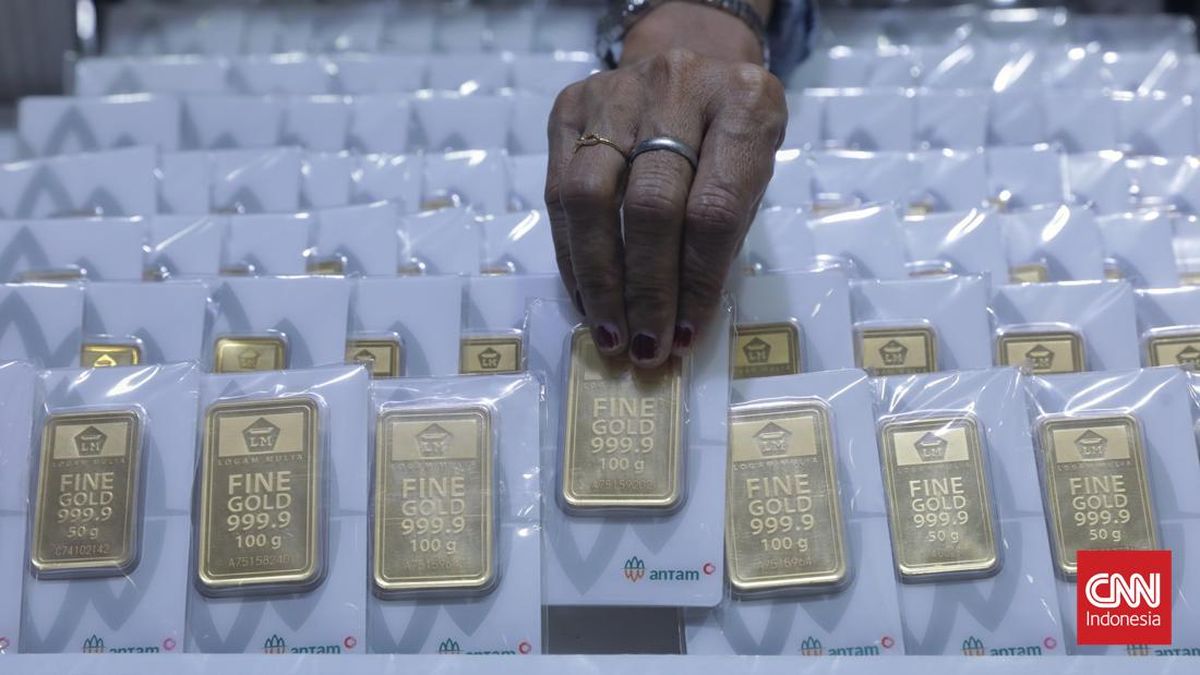Opinion
October 22, 2025 — 12.01pm
October 22, 2025 — 12.01pm
The steep plunge in precious metals prices overnight was almost predestined. They had run up too hard and too far, and some of the factors behind the surge suddenly had a question mark next to them.
The simplest explanation for the biggest one-day fall in the gold price in more than a decade, and similarly hefty drops in silver and platinum prices, is profit-taking. After soaring more than 60 per cent this year, the precious metal was overdue some level of correction.

Gold had the biggest price slump in more than a decade overnight.Credit: Bloomberg
Indications of how overheated the gold price had become were the queues of punters lining up at gold exchanges to buy into the boom, while others rushed to sell unwanted jewellery to cash out while the price remained at stratospheric levels. Those were signals to professional investors that the market was nearing breaking point.
The catalyst for the plunge – the spot price of gold was down more than 6 per cent at one point, and silver more than 7 per cent – may have been a modest appreciation in the US dollar, which rose 0.4 per cent against the basket of America’s major trading partners.
Precious metals are priced in US dollars, which have depreciated about 11 per cent on a trade-weighted basis this year. That big slide made it cheaper for foreign investors to acquire gold and other commodities. Conversely, any rise in the dollar makes it more expensive.
The US dollar has been tumbling this year, largely for Donald Trump-related reasons.
Gold may have given back what is really just a modest portion of the gains it has experienced this year, but it hasn’t lost its lustre.
His trade wars, the peculiar nature of his cabinet and the decisions it has made, the big shifts in America’s relationships with the rest of the world, the question marks they have raised over the strength of the rule of law, the dysfunction in Congress, the blowout in the US deficits and debt caused by Trump’s One Big Beautiful Bill, his attempted assault on the Federal Reserve Board’s independence, rising inflation, increasing unemployment and the shutdown of the US government are all reasons to shun the greenback and seek havens elsewhere.
Separately, central banks around the world have been busily building their stockpiles of gold as part of a trend towards “de-dollarisation”, having become nervous after the seizing of Russia’s dollar-denominated offshore assets in 2022 and the increasing weaponisation of the US dollar’s dominance of global finance and trade to support Washington’s geopolitical aims.
There’s also the “debasement” trade, with investors reducing their holdings of sovereign debt and exposures to fiat currencies because they fear heir value will erode as the US and other overly indebted governments are eventually forced to tackle their debt burdens by printing more money. That’s another macro reason to buy gold.
Loading
At a more micro level, falling interest rates in the US – even with the inflation rate edging up as the impact of Trump’s tariffs starts to flow through – have been a factor in the sell-off of the dollar. Gold generates no income but for traders carries both holding and opportunity costs.
The slide in US rates – from mid-January the yield on the benchmark 10-year US government bond has tumbled from 4.78 per cent to 3.96 per cent – has helped reduce those costs of holding gold, while the inflation rate has, thanks largely to Trump’s tariffs, jumped from 2.3 per cent in April to 2.9 per cent in August.
Inflation data for September has been delayed by America’s government shutdown, but is expected to be released on Friday. Market forecasts are for another rise to 3.1 per cent, which would normally be a positive for the gold price, given bullion’s perceived role as a hedge against inflation.
There are, however, other developments looming that will overshadow the release of the inflation data.
Next week, the Federal Reserve Board meets amid expectations that it will cut its policy rate for the second time this year, although that isn’t a given, particularly if inflation is higher than expected.
Perhaps of greater significance, there is also a scheduled meeting of Trump and China’s President Xi Jinping on the sidelines of the Asia Pacific Economic Cooperation summit in South Korea, which starts on Tuesday.
Trump’s initial response to China’s announcement of tightened controls over exports of rare earths and rare earth magnets was to angrily threaten 100 per cent tariffs on all US imports from China.
Almost immediately, however, he backed away, adopted a conciliatory tone and started talking about the “really great” deal – “fantastic for both countries, and it’s going to be fantastic for the entire world” – that he hopes to negotiate with Xi.
China’s dominance of rare earths, vital for most advanced manufacturing and weapons, means that Xi enters any trade discussion with Trump holding by far the more potent hand, regardless of Trump’s bombastic talk of America’s strengths.
The optimistic prospect of a trade deal that defuses the tensions between the world’s two key economies is a negative for the gold price.
Gold thrives in environments where there is fear, uncertainty and volatility. It is instructive that Wall Street’s so-called “fear index” – the VIX index – which measures market volatility, spiked in response to China’s new rare earths export rules and what appeared to be an abrupt rise in trade tensions, before subsiding when Trump started making more placatory noises.
Another possible ingredient in the mix that helped trigger the steep gold price fall is the fallout from the US government shutdown, which has impacted more than just the inflation data.
Loading
With a lot of economic and financial data not being collected because workers have been furloughed and agencies effectively closed, commodity traders have lost access to the weekly report from the Commodity Futures Trading Commission that provides them with insights into how hedge funds and other institutional investors are positioned in gold and silver futures.
They are operating within an information vacuum, which tends to make investors nervous and defensive. Given how far and how fast gold and silver prices had run up – the gold price jumped about $US1000 an ounce in less than two months – it’s not surprising that some traders decided to reduce their exposure.
Having said that, the fundamentals for gold and other precious metals remain solid.
While the global economy has held up better than expected in the face of Trump’s trade wars, their full impact won’t be seen until next year.
Loading
US and global debt levels remain extremely high and are still rising.
Geopolitical tensions may or may not wane, but they won’t disappear.
Central banks will continue to increase their gold holdings as a strategy for diversifying away from dollar-denominated assets, and they and their governments will also look for new trading partners and new currencies for trade after Trump has made it clear that historic relationships and institutions no longer matter to the US.
The US inflation rate is likely to continue to rise, which may or may not be transitory, and its deficits and debt levels will continue to build.
Political dysfunction – not just in America but in other major developed economies – will continue.
Gold may have given back what is really just a modest portion of the gains it has experienced this year, but it hasn’t lost its lustre. Most of the underlying factors that drove those gains remain.
The Market Recap newsletter is a wrap of the day’s trading. Get it each weekday afternoon.
Most Viewed in Business
Loading








































